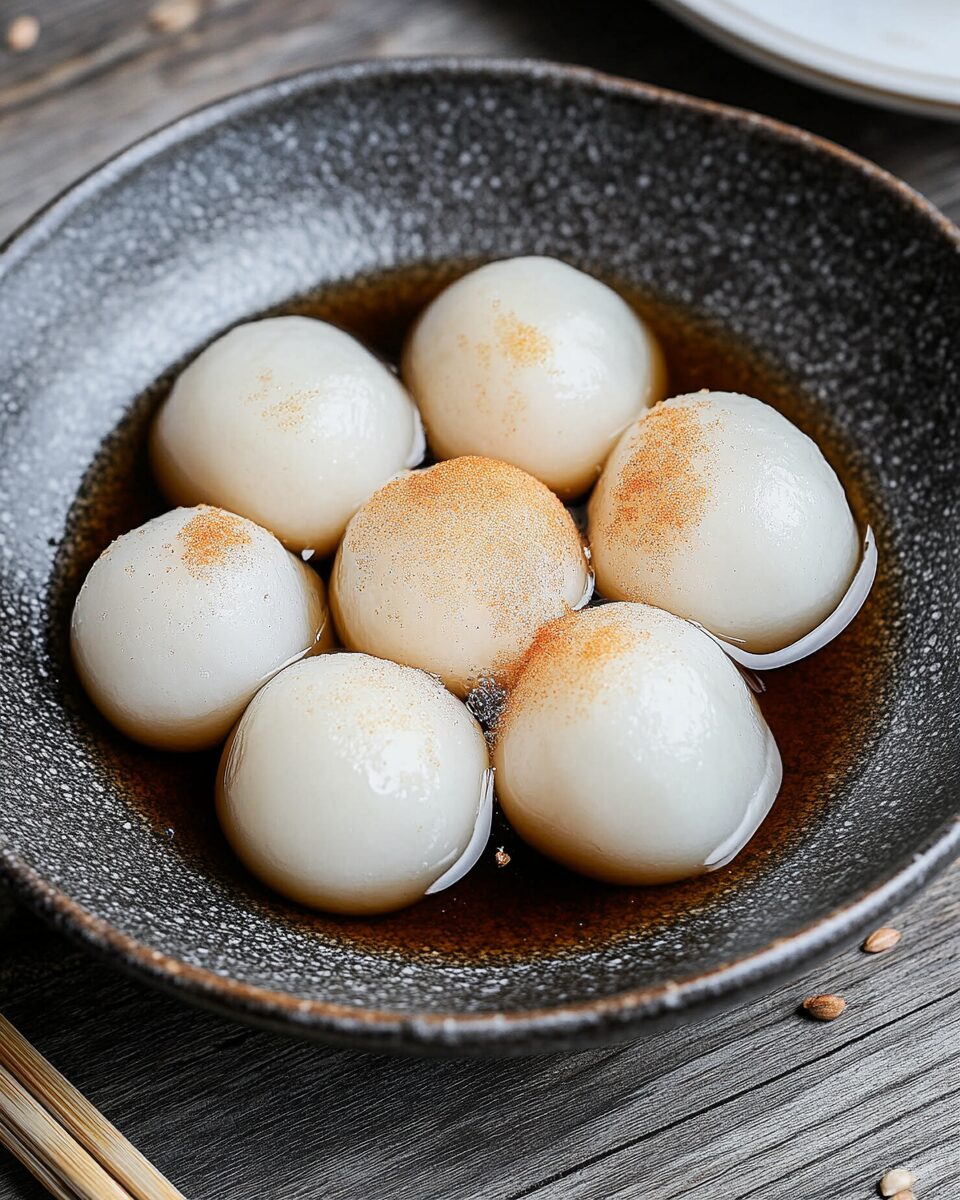The charm of Shiratama Dango lies in its simplicity and purity of flavor. Made with just glutinous rice flour and water, these chewy Japanese dumplings are a staple in traditional sweets known as wagashi. Once boiled and cooled, they’re topped with kinako, a nutty roasted soybean flour, and kuromitsu, a rich black sugar syrup that perfectly complements their subtle texture. Ideal for hot summer days or a light dessert after a savory meal, Shiratama Dango is quick to prepare, visually beautiful, and endlessly customizable. Try pairing them with matcha, fresh fruit, or even ice cream for a fusion twist. Whether served at a tea ceremony or casual family table, this dish captures the elegant minimalism of Japanese cuisine.
Full Recipe:
Ingredients:
-
100g shiratamako (glutinous rice flour)
-
80-90ml water
-
2 tbsp kinako (roasted soybean flour)
-
1 tbsp sugar (for mixing with kinako)
-
Kuromitsu (Japanese black sugar syrup), for drizzling
Directions:
-
Place shiratamako in a bowl and gradually add water while mixing by hand.
-
Knead until a soft, pliable dough forms. It should feel like an earlobe – not too dry or sticky.
-
Divide the dough into equal portions and roll each into a small ball.
-
Bring a pot of water to a gentle boil and carefully drop in the shiratama.
-
Boil until the dumplings float to the surface (about 2–3 minutes), then cook 1 more minute.
-
Remove with a slotted spoon and immediately place into a bowl of ice water. Let cool for 1–2 minutes.
-
Drain and arrange on a plate.
-
Mix the kinako with sugar and sprinkle over the dumplings.
-
Drizzle generously with kuromitsu before serving.
Prep Time: 10 minutes | Cooking Time: 5 minutes | Total Time: 15 minutes
Kcal: 190 kcal | Servings: 2 servings
What is Shiratama Dango?
Shiratama Dango is a traditional Japanese dessert made from glutinous rice flour (specifically shiratamako) and water. These soft, chewy rice dumplings are a classic element in Japanese cuisine and are often enjoyed with various toppings or sauces like kinako (roasted soybean flour), anko (sweet red bean paste), or kuromitsu (Japanese black sugar syrup). They are part of a larger category of sweets known as wagashi handcrafted confections often served with tea.
Unlike regular mochi, which is made by steaming and pounding whole glutinous rice, shiratama dango uses a flour that simplifies the process. The result is a dumpling that is smooth, tender, slightly chewy, and very easy to prepare at home, even for beginners. They are usually bite-sized, making them perfect for small indulgent treats or elegant dessert platings.
Cultural Background and History
The term dango broadly refers to Japanese dumplings made from rice flour or glutinous rice, and it has been a part of Japanese food culture for centuries. Dango is often associated with Japanese festivals, seasonal celebrations, and religious rituals. It’s common to see dango skewers at temple fairs or hanami (cherry blossom viewing) events, where people gather outdoors to enjoy the blooming sakura trees.
Shiratama dango, in particular, is appreciated for its smooth, pillowy texture and neutral flavor, which makes it a versatile base for both traditional and modern desserts. The name “shiratama” translates to “white jewel,” referencing the glossy, round, and delicate appearance of these dumplings when freshly cooked.
Why Shiratama Dango Is So Beloved
What sets shiratama dango apart from other mochi or dumpling desserts is its remarkable texture. It is slightly chewy but tender enough to melt in your mouth. This mouthfeel, called mochi mochi in Japanese, is a cherished quality in many Japanese foods, especially sweets.
Another reason this dessert is so popular is its flexibility. It can be served warm or cold and topped with a variety of sweet (and sometimes savory) accompaniments. From traditional pairings like red bean paste and roasted soybean flour to contemporary additions like matcha syrup, fruit, or even ice cream, shiratama dango is like a blank canvas for creativity in flavor and presentation.
Health Benefits of Shiratama Dango
Shiratama dango, while a dessert, can be a surprisingly light and wholesome treat depending on the toppings used. Here are some of its nutritional and health-related advantages:
-
Gluten-Free: Since it’s made entirely from glutinous rice flour and water, shiratama dango is naturally gluten-free, making it a great dessert option for people with celiac disease or gluten sensitivities.
-
Low in Fat: On its own, the dumpling contains virtually no fat. Any added calories usually come from toppings like syrup or sweet bean paste, which can be adjusted to suit your preferences.
-
Plant-Based: Shiratama dango is vegan by default and pairs well with other plant-based ingredients, making it a go-to dessert for people following a vegetarian or vegan diet.
-
Simple and Minimalist: With only two core ingredients, the dish avoids additives and preservatives, aligning well with clean eating and whole-food-based diets.
Popular Ways to Serve Shiratama Dango
One of the reasons this dessert has stood the test of time is its adaptability. Here are some popular and delicious ways shiratama dango is enjoyed:
-
Kinako and Kuromitsu: One of the most classic pairings, where the dumplings are dusted with roasted soybean flour and drizzled with thick, molasses-like black sugar syrup. This version is nutty, sweet, and deeply satisfying.
-
Zenzai (Sweet Red Bean Soup): In colder months, shiratama dango is served in a warm bowl of sweet azuki bean soup for a comforting dessert that feels like a warm hug.
-
Anmitsu: A popular Japanese dessert plate where shiratama dango are served with cubes of agar jelly, sweet fruit slices, red bean paste, and kuromitsu.
-
Matcha Syrup or Ice Cream: For matcha lovers, pairing the dumplings with matcha syrup or a scoop of matcha ice cream adds a modern, bitter contrast to the mild sweetness of the dish.
-
Seasonal Fruits: Shiratama dango served with strawberries, peaches, or melon makes for a refreshing summer treat.
Occasions to Enjoy Shiratama Dango
Shiratama dango isn’t just reserved for everyday indulgence it often plays a role in cultural and seasonal celebrations. Here’s when and how it’s typically enjoyed:
-
Hanami (Cherry Blossom Viewing): A must-have treat for spring picnics under blooming sakura trees.
-
New Year Celebrations: Often served with auspicious toppings symbolizing prosperity and happiness.
-
Mid-Autumn Festival (Tsukimi): Moon-viewing parties often include a version of dango to symbolize the full moon.
Its simple preparation and beautiful presentation make it ideal for formal tea ceremonies or casual gatherings alike.
Modern Interpretations and Fusion Ideas
While shiratama dango has deep roots in Japanese tradition, it has also evolved in modern culinary circles. With the growing popularity of Japanese sweets worldwide, chefs and home cooks alike are experimenting with unique presentations and global flavor profiles:
-
Tropical Toppings: Add coconut milk, mango, or passionfruit syrup for a Southeast Asian twist.
-
Chocolate Drizzle and Nuts: Blend East and West with a chocolate drizzle, crushed pistachios, or toasted almonds.
-
Flavored Doughs: Add matcha powder, black sesame, or fruit purees into the dough itself for colorful, flavored dumplings.
These innovations have helped introduce shiratama dango to global dessert menus while keeping its authentic charm intact.
Why You Should Try Making Shiratama Dango at Home
Making shiratama dango is quick, fun, and incredibly satisfying. The entire process from mixing the dough to forming the dumplings and watching them rise to the top of boiling water is meditative and family-friendly. Even kids can join in!
Since the recipe requires minimal ingredients and no baking, it’s ideal for those who may not have access to a full kitchen setup. You can even batch-make and freeze the dumplings for future use.
Advertisement
If you’re a fan of mochi or other glutinous rice-based desserts, shiratama dango offers a similar experience but with a more refined and delicate bite. It’s a rewarding gateway into Japanese confectionery that requires no special skills or equipment.
Conclusion:
Shiratama Dango is more than just a sweet rice dumpling it is a symbol of Japanese tradition, simplicity, and versatility. Whether you’re honoring a cultural tradition or just craving something chewy and sweet, shiratama dango delivers comfort, flavor, and beauty in every bite. Its gluten-free and vegan-friendly nature also makes it widely accessible to people of various dietary lifestyles.
The ease of preparation and the variety of toppings ensure that you’ll never get bored of this elegant dessert. So whether you’re enjoying it with a drizzle of kuromitsu, a dusting of kinako, or even a scoop of matcha ice cream, Shiratama Dango is a timeless treat that brings a little piece of Japan into your home.

